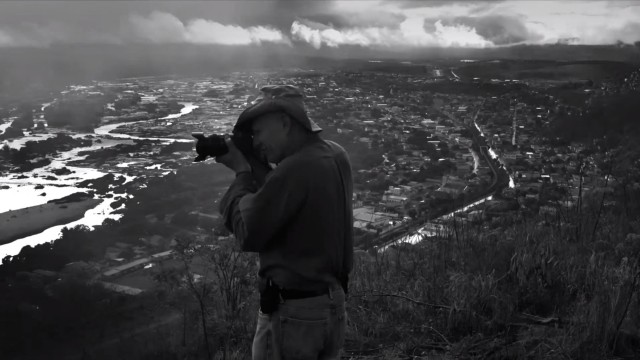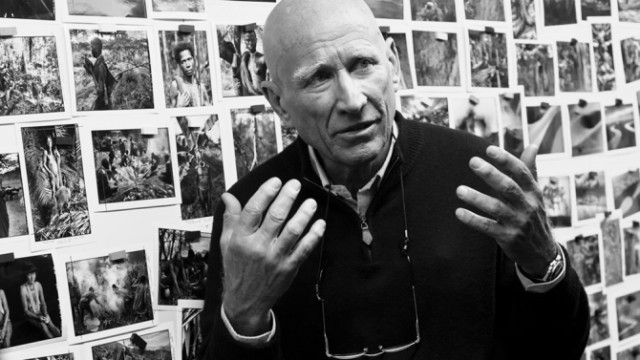
Sebastião Salgado is shown photographing the planet — and trying to save the world — in THE SALT OF THE EARTH
THE SALT OF THE EARTH (Wim Wenders & Juliano Ribero Salgado, 2014)
MoMA Film, Museum of Modern Art
11 West 53rd St. between Fifth & Sixth Aves.
Saturday, March 7, 7:45
Series runs March 2-17
Tickets: $12, in person only, may be applied to museum admission within thirty days, same-day screenings free with museum admission, available at Film and Media Desk beginning at 9:30 am
212-708-9400
www.sonyclassics.com
www.moma.org
 Over the course of his storied five-decade career, German-born auteur and photographer Wim Wenders has alternated between making documentaries, primarily about other artists (Pina Bausch, Yasujirō Ozu, the Buena Vista Social Club) and fiction films, often unique takes on the road movie in which photographs play a key role (Paris, Texas; Alice in the Cities, Kings of the Road). In his latest work, Wenders has found one subject that combines his many interests, as he follows the remarkable adventures of Brazilian photographer and environmentalist Sebastião Salgado, who has traveled the world taking stunning pictures of the land and native peoples. In The Salt of the Earth, which was nominated for a Best Documentary Feature Oscar and won the Un Certain Regard special jury prize at the Cannes Film Festival and the César at France’s national film awards, Wenders teams up with Salgado’s son, filmmaker Juliano Ribero Salgado (Suzana; Nauru, an Island Adrift), as they accompany Salgado on his journeys and talk about his work, which consists predominantly of black-and-white photographs in such social justice series as “Workers” and “Migrations” and his most recent, the nature-themed“Genesis,” which was just shown at ICP. In the documentary, Salgado is shown rolling around on a shore to get a picture of a polar bear in the Arctic Circle, heading down into the mines of Brazil, meeting the Yali in Papua New Guinea, and sitting on a mountain, contemplating the future of the planet.
Over the course of his storied five-decade career, German-born auteur and photographer Wim Wenders has alternated between making documentaries, primarily about other artists (Pina Bausch, Yasujirō Ozu, the Buena Vista Social Club) and fiction films, often unique takes on the road movie in which photographs play a key role (Paris, Texas; Alice in the Cities, Kings of the Road). In his latest work, Wenders has found one subject that combines his many interests, as he follows the remarkable adventures of Brazilian photographer and environmentalist Sebastião Salgado, who has traveled the world taking stunning pictures of the land and native peoples. In The Salt of the Earth, which was nominated for a Best Documentary Feature Oscar and won the Un Certain Regard special jury prize at the Cannes Film Festival and the César at France’s national film awards, Wenders teams up with Salgado’s son, filmmaker Juliano Ribero Salgado (Suzana; Nauru, an Island Adrift), as they accompany Salgado on his journeys and talk about his work, which consists predominantly of black-and-white photographs in such social justice series as “Workers” and “Migrations” and his most recent, the nature-themed“Genesis,” which was just shown at ICP. In the documentary, Salgado is shown rolling around on a shore to get a picture of a polar bear in the Arctic Circle, heading down into the mines of Brazil, meeting the Yali in Papua New Guinea, and sitting on a mountain, contemplating the future of the planet.

Sebastião Salgado talks about his life and work in Oscar-nominated documentary directed by his son and Wim Wenders
Salgado is not only photographing parts of the world devoid of technological modernity but is also involved, with his wife and curator, Lélia Wanick Salgado, in returning to nature, having planted more than two million trees to rebuild part of the Atlantic Forest on his family’s land in Brazil and starting Instituto Terra, a nonprofit community organization dedicated to restoring the ecosystem. “A photographer is literally somebody drawing with light, a man writing and rewriting the world with light and shadows,” Wenders narrates in the film. “Little did I know that I was going to discover much more than just a photographer.” Using a semitransparent mirror, Wenders also conducts interviews with Salgado, who is seen in front of a screen, looking at his photographs while discussing them. Other times the only thing on camera is Salgado’s bald head against a black background, as he peers into the camera to share his tale, including his relationship with his wife and children. “If you put many photographers in one place, they’ll all take very different pictures,” Salgado says. “Each one forms their way of seeing according to their history.” As The Salt of the Earth ably displays, Salgado has a fascinating history. The Salt of the Earth is being shown at MoMA on March 7 at 7:45 as part of a two-plus-week Wenders retrospective in advance of the film’s March 27 theatrical release; Wenders, who just received the Golden Bear for lifetime achievement at the Berlin Film Festival, and Juliano Ribero Salgado, whose next film will be a psychological thriller, will introduce the work and participate in a postscreening discussion. The series continues through March 17 with such other Wenders films as The American Friend, Wings of Desire, Until the End of the World, Tokyo-Ga, The Goalie’s Anxiety at the Penalty Kick, and other well-known gems and rare early shorts, with Wenders at the museum for Q&As and introductions at all screenings through March 7.